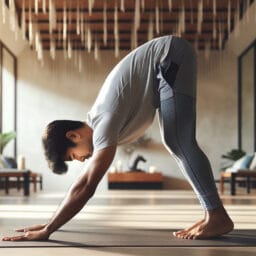
Top Yoga Poses to Alleviate Lower Back Pain
Table of Contents
- Introduction
- Understanding Lower Back Pain
- Top Yoga Poses for Lower Back Pain
- How to Perform These Poses
- Precautions and Tips
- Conclusion
- Frequently Asked Questions
Introduction
Lower back pain is a common ailment that affects millions of individuals worldwide, impacting both physical and mental health. In an increasingly sedentary world, it has turned into an almost epidemic-like condition being faced by people across different age groups. But here’s an interesting fact: studies suggest that yoga poses can be an effective way to relieve lower back pain. The gentle stretches and strengthening exercises in a yoga program could be the solution you’ve been searching for to not only relieve stress but also alleviate this chronic discomfort.
Yoga works to strengthen your core and back muscles, which play crucial roles in supporting your lower spine. Poses such as the downward dog or child’s pose offer great stretch for your upper body while providing relief for your lower back. As per the advice of certified yoga teachers and ace-certified personal trainers, positions like these when done correctly under safety instructions can help eliminate low back pain effectively.
Incorporating these poses into your exercise program may seem daunting if you’ve never studied yoga before, but with guidance from a skilled professional such as a physical therapist or experienced instructor, you can safely learn these techniques. Imagine yourself on the yoga mat: knees bent in tabletop position; arms extended ahead; belly button engaged towards your spine; all while maintaining focus on mindful breathing – this visualization itself is therapeutic.
However, tackling physical injury or issues like neck pain due to incorrect postures calls for careful attention – always keep in mind that each individual’s response to various poses could differ based on their body type and flexibility levels.
Remember, apart from offering lower back pain relief through physical benefits like increased strength and flexibility, Yoga also helps improve mental wellbeing by helping individuals manage stress better—working twofold to tackle both physiological factors and psychological elements related to low-back-pain-associated distress will make Yoga’s role indispensable in our lives!
Understanding Lower Back Pain
A surprising statistic reveals that approximately 80% of adults will experience lower back pain at some point in their lives. This discomfort, often a result of sedentary lifestyles or poor posture, can significantly hamper quality of life and mental health. However, the ancient practice of Yoga offers an effective solution to this ubiquitous problem.
Yoga is more than just gentle stretching; it’s a holistic exercise program that strengthens the body and calms the mind. It helps in alleviating lower back pain by enhancing flexibility and strengthening back muscles – critical components for supporting your spine. Certified yoga teachers often recommend poses like ‘downward dog’ and ‘child’s pose’. The downward dog works wonders on your upper body while extending your sitting bones upwards, creating a great stretch for your back muscles. Similarly, child’s pose allows you to rest and focus on breathing while giving relief to both your shoulders and lower back.
The versatility of yoga poses goes beyond physical benefits: they also help in relieving stress, contributing positively towards mental health. Stress is often an overlooked element when discussing causes for low-back pain – chronic stress could lead to muscle tension in the lower back region causing persistent discomfort.
Knees bent with arms extended ahead in tabletop position or easy lower back stretches following safety instructions from an ace-certified personal trainer or physical therapist can provide significant relief from recurring pains as well as prevent potential injury due to incorrect postures or movements.
However, it is important to note that everyone’s response may vary based on individual health conditions and flexibility levels – what provides one person with lower back pain relief might not work similarly for another! Therefore, be patient with yourself while practicing Yoga; listen carefully to your body signals when trying even the easiest or hardest yoga poses.
But remember—while these practices help eliminate low-back pain effectively over time without resorting to invasive procedures or medications—a consistent approach is key here. Incorporating these beneficial Yoga exercises into our daily routine will not only help us relieve lower back aches but also contribute to overall wellbeing in terms of physical health and mental tranquility.
Top Yoga Poses for Lower Back Pain
The ancient practice of Yoga, with its myriad health benefits, has stood the test of time, proving itself as an effective antidote to the modern-day ailment of lower back pain. Amongst the plethora of yoga poses available, Child’s Pose (Balasana), for instance, offers vast relief to your lower back by stretching and elongating your spine. In addition to instilling a sense of tranquility and calmness, it allows you to gently work on your flexibility whilst focusing on deep diaphragmatic breathing that aids in reducing stress levels.
Transitioning next into Cat-Cow Pose (Marjaryasana-Bitilasana) can be particularly beneficial as it involves intentional movement with breath—engaging your belly button towards the spine during exhalation in cat pose and allowing a gentle arch in your back while inhaling into cow pose. This dynamic flow enhances spinal fluid circulation and strengthens not just your back muscles but also targets abdominal muscles thereby contributing significantly towards a robust core—a key component for lower back support.
A certified yoga teacher would undoubtedly recommend including Downward-Facing Dog (Adho Mukha Svanasana) in any exercise program aiming at relieving lower back pain. A well-executed downward dog—with arms extended ahead, fingers spread wide pressing onto the mat; hips raised forming an inverted V shape; heels grounded or slightly lifted depending upon personal flexibility—offers profound upper body stretch from arms through shoulders down to hamstrings while strengthening crucial muscle groups all at once.
One cannot overlook Pigeon Pose (Eka Pada Rajakapotasana) when discussing yoga poses pivotal for low-back pain relief: an ace-certified personal trainer would guide you through this hip opener that also works wonders for emotional release often held within our hip region leading onto stress-induced discomforts like neck pain or shoulder tension apart from being highly effective against sciatica—a common cause behind severe low-back pains.
Last but not least, Triangle Pose (Trikonasana) renders a great stretch to your entire body while improving overall equilibrium and stability. With one foot placed forward in line with your hand reaching towards the same side and other arm extended upwards forming a ‘triangle’, this pose strengthens the legs, reduces stiffness in hips and serves as an extremely beneficial yoga pose for those working long hours in seated positions leading onto potential stool lower back pain.
While incorporating these poses into your routine, remember that each individual’s flexibility levels vary—so don’t push yourself beyond comfort zones; instead, aim for steady progress under safety instructions from trained professionals. With consistent practice alongside mindful breathing techniques, Yoga can surely help eliminate low back pain while enhancing mental health by strengthening our resilience against stress—a holistic approach indeed!
| Yoga Pose | Description | Benefits |
|---|---|---|
| Child’s Pose (Balasana) | Relief to your lower back by stretching and elongating your spine. | Instills a sense of tranquility and calmness, gently works on flexibility, reduces stress levels. |
| Cat-Cow Pose (Marjaryasana-Bitilasana) | Intentional movement with breath—engaging your belly button towards the spine during exhalation in cat pose and allowing a gentle arch in your back while inhaling into cow pose. | Enhances spinal fluid circulation, strengthens back and abdominal muscles, contributes towards a robust core. |
| Downward-Facing Dog (Adho Mukha Svanasana) | Arms extended ahead, fingers spread wide pressing onto the mat; hips raised forming an inverted V shape; heels grounded or slightly lifted depending upon personal flexibility. | Offers profound upper body stretch from arms through shoulders down to hamstrings while strengthening crucial muscle groups. |
| Pigeon Pose (Eka Pada Rajakapotasana) | Hip opener that works wonders for emotional release. | Highly effective against sciatica—a common cause behind severe low-back pains, relieves stress-induced discomforts like neck pain or shoulder tension. |
| Triangle Pose (Trikonasana) | One foot placed forward in line with your hand reaching towards the same side and other arm extended upwards forming a ‘triangle’. | Strengthens the legs, reduces stiffness in hips, beneficial for those working long hours in seated positions leading onto potential stool lower back pain. |
How to Perform These Poses
Despite prevalent misconceptions, the hardest yoga poses are not necessarily the most beneficial for relieving lower back pain. A certified yoga teacher would advise that it’s often the simplest postures, like the Child’s Pose or Downward Dog, which provide substantial relief. Each pose is uniquely designed to target different areas of tension in your body; hence, a well-rounded exercise program will incorporate a diverse mix of these positions.
Child’s Pose, for instance, is an incredibly gentle stretch that targets both your upper body and lower back simultaneously. As you fold forward with knees bent and arms extended ahead in this therapeutic pose, you create space in your spine and alleviate any discomfort lodged there. The soothing posture also invites a moment of stillness grounded in mindful breathing—an excellent way to relieve stress!
On the other hand, Downward Dog offers an intense yet gratifying stretch for your entire body—the great stretch is felt from the tips of your fingers down through your back muscles all the way to your sitting bones! This traditional pose requires strength as well as flexibility; thus it aids in toning vital muscle groups while providing a deep elongation effect on stiff segments –a sure-fire recipe for lower back pain relief!
Let’s not forget about Tabletop position—a perfect warm-up before transitioning into more challenging postures—this simple position involves keeping knees bent at right angles with hands directly under shoulders forming a “tabletop”. It’s extremely effective against stool-related lower back pain commonly experienced by those leading sedentary lifestyles.
Adopting easy lower back stretches under careful guidance from an ace-certified personal trainer or physical therapist can help ward off potential physical injury while gradually improving overall flexibility levels. Moreover, taking heed of safety instructions such as engaging core by drawing belly button towards spine during poses is crucial—it contributes towards protecting our backs from undue stress while reinforcing core stability.
Aside from their direct impact on our bodies physically—increasing strength and range of motion—these yoga poses also contribute significantly towards mental health. The meditative component of yoga cultivates mindfulness—it trains us to focus on our breath and be present in the moment, which can significantly reduce anxiety levels and improve our overall mood.
While the journey to eliminate low back pain may prove challenging initially, with consistency, patience and adherence to correct postures under professional guidance, Yoga proves an effective and non-invasive solution. Incorporating these poses into your daily routine will not only alleviate lower back aches but also bestow a host of additional benefits including improved posture, increased flexibility, better stress management capabilities—making you stronger in both body and mind!
Precautions and Tips
Delving into the realm of Yoga to alleviate lower back pain can be a transformative journey, but it’s essential for beginners to take necessary measures to ensure their safety. As beneficial as yoga poses may appear, incorrect postures or overstretching can lead to physical injuries. This makes the role of an ace-certified personal trainer or a skilled physical therapist pivotal in your exercise program – they guide you through each pose with proper alignment and help modulate the intensity based on your flexibility level.
Kickstarting this wellness journey, one might begin with gentle stretching exercises like Child’s Pose which not only offers great relief for the lower back but also serves as a soothing balm for mental health by helping us relieve stress. Transitioning from this calming posture onto more dynamic poses such as Downward Dog, be mindful about maintaining correct form – arms extended ahead with even pressure across palms; upper body stretched while sitting bones reaching towards sky creating an inverted ‘V’. Remember, these subtle nuances in every pose are what make Yoga an effective solution against low back pain.
Bringing focus onto our core is crucial too. Simple yet powerful positions like Tabletop Position where knees are bent under hips and hands resting beneath shoulders invite us to engage our belly button towards spine – offering significant support and stability thereby minimizing potential strain on our back muscles.
While mastering hardest yoga poses might seem like an attractive goal, remember that every individual’s response varies greatly based on personal health conditions and inherent flexibility levels. It’s vital not just to perform these poses but also comprehend their underlying benefits – how they strengthen key muscle groups contributing towards overall physique enhancement apart from providing specific lower back pain relief.
Incorporating these easy lower back stretches will unquestionably pave way not just towards eliminating recurring low-back pains but also enhancing one’s resilience against chronic stress factors affecting mental health positively. With consistent practice under professional guidance adhering strictly to safety instructions, we take steady strides towards achieving holistic health and wellbeing. Remember, Yoga isn’t a quick fix but a lifestyle – the key is to be patient with oneself, maintaining consistent practice while honouring our bodies’ unique pace of progress.
Conclusion
A unique observation on yoga for alleviating lower back pain focuses on the transformative power of this ancient practice, introducing a holistic approach to manage and eliminate chronic discomfort. With daily practice under the guidance of an ace-certified personal trainer or certified yoga teacher, incorporating gentle stretches into your exercise program can dramatically improve both physical and mental health. Yoga poses like downward dog, child’s pose, and tabletop position work to strengthen key back muscles while providing a great stretch to the upper body. Knees bent in pose positions help align your sitting bones correctly, achieving relief for persistent neck pain and potential stool lower back pain issues associated with sedentary lifestyles. At the same time, focused breathing techniques instill tranquility and relieve stress—an underestimated factor contributing to low-back-pain-associated distress. This mindful engagement with our bodies helps us understand individual flexibility levels better as we progress from easy lower back stretches towards attempting hardest yoga poses—enhancing our resilience against physical injuries while ensuring safety instructions are adhered strictly. So why not roll out that yoga mat? The journey toward not only relieving lower back aches but also towards overall well-being is just a few mindful breaths away!



